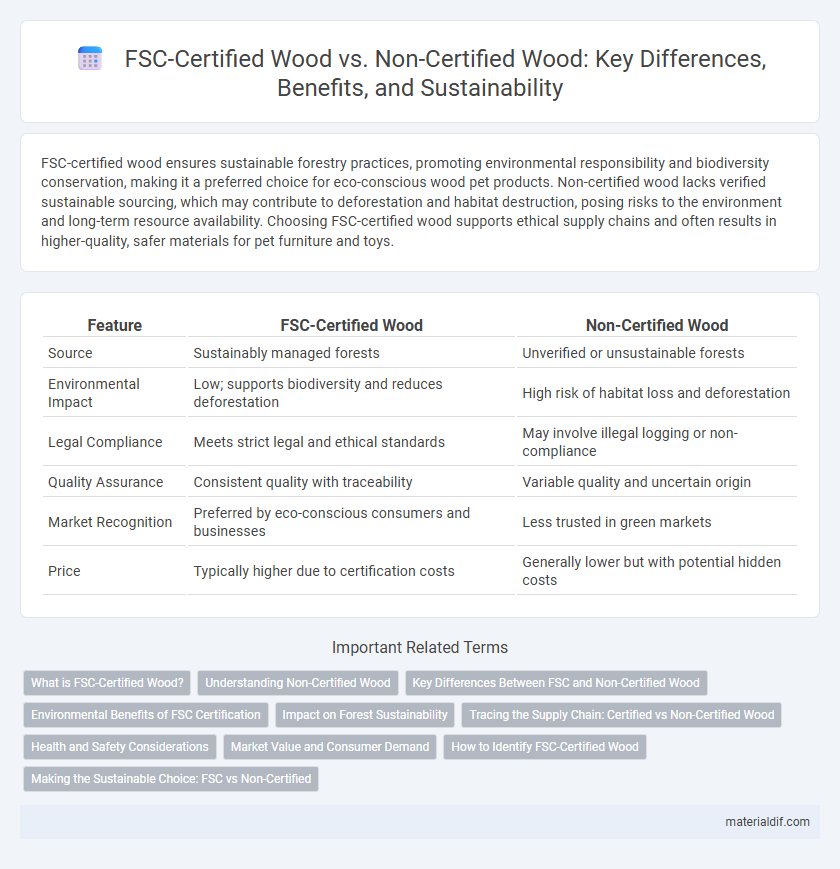FSC-certified wood ensures sustainable forestry practices, promoting environmental responsibility and biodiversity conservation, making it a preferred choice for eco-conscious wood pet products. Non-certified wood lacks verified sustainable sourcing, which may contribute to deforestation and habitat destruction, posing risks to the environment and long-term resource availability. Choosing FSC-certified wood supports ethical supply chains and often results in higher-quality, safer materials for pet furniture and toys.
Table of Comparison
| Feature | FSC-Certified Wood | Non-Certified Wood |
|---|---|---|
| Source | Sustainably managed forests | Unverified or unsustainable forests |
| Environmental Impact | Low; supports biodiversity and reduces deforestation | High risk of habitat loss and deforestation |
| Legal Compliance | Meets strict legal and ethical standards | May involve illegal logging or non-compliance |
| Quality Assurance | Consistent quality with traceability | Variable quality and uncertain origin |
| Market Recognition | Preferred by eco-conscious consumers and businesses | Less trusted in green markets |
| Price | Typically higher due to certification costs | Generally lower but with potential hidden costs |
What is FSC-Certified Wood?
FSC-certified wood comes from forests managed according to the rigorous standards set by the Forest Stewardship Council, ensuring sustainable harvesting practices that protect biodiversity, water resources, and Indigenous rights. This certification guarantees that the wood has been sourced responsibly, promoting environmental integrity and social benefits throughout the supply chain. Non-certified wood lacks these assurances, potentially contributing to deforestation, habitat loss, and unethical labor practices.
Understanding Non-Certified Wood
Non-certified wood lacks verification from organizations like the Forest Stewardship Council (FSC), raising concerns about sustainable forest management and legality. This wood may contribute to deforestation, habitat loss, and unethical labor practices due to insufficient oversight. Buyers seeking environmentally responsible products should consider the risks associated with non-certified wood sources.
Key Differences Between FSC and Non-Certified Wood
FSC-certified wood guarantees sustainable forest management, ensuring traceability, reduced environmental impact, and social responsibility throughout the supply chain. Non-certified wood lacks verified sustainability standards, often contributing to deforestation, habitat loss, and unclear sourcing practices. Choosing FSC-certified wood supports biodiversity preservation and ethical forestry, whereas non-certified wood presents risks related to legality and ecological damage.
Environmental Benefits of FSC Certification
FSC-certified wood ensures sustainable forest management by promoting biodiversity conservation, reducing deforestation, and protecting water quality. This certification supports ecosystems by enforcing strict guidelines that prevent illegal logging and forest degradation. Choosing FSC-certified wood significantly lowers the environmental impact compared to non-certified wood, thereby contributing to global efforts in combating climate change.
Impact on Forest Sustainability
FSC-certified wood ensures responsible forest management by promoting biodiversity, preventing deforestation, and supporting local communities, which directly contributes to forest sustainability. Non-certified wood often comes from sources with unclear or unsustainable practices, increasing risks of habitat loss and ecological imbalance. Choosing FSC-certified wood supports long-term environmental health and sustainable resource use.
Tracing the Supply Chain: Certified vs Non-Certified Wood
FSC-certified wood ensures traceability through a verified supply chain, linking forests, manufacturers, and retailers to promote sustainable forestry practices. Non-certified wood lacks this transparency, increasing the risk of illegal logging and environmental harm due to unclear sourcing. Traceability in certified wood supports responsible forest management and consumer confidence in environmental claims.
Health and Safety Considerations
FSC-certified wood is harvested following strict environmental and social standards, reducing exposure to harmful chemicals and promoting safer working conditions for laborers. Non-certified wood may come from sources with unknown treatments or contaminants, increasing risks of toxic residues and unsafe handling practices. Ensuring wood is FSC-certified supports healthier indoor air quality and minimizes health hazards associated with chemical preservatives and deforestation-related toxins.
Market Value and Consumer Demand
FSC-certified wood commands higher market value due to its sustainable sourcing and environmental benefits, attracting eco-conscious consumers willing to pay a premium. Consumer demand for FSC-certified wood is rising sharply as awareness of deforestation and ethical forestry practices grows globally. Non-certified wood often faces lower demand and market prices because it lacks verified sustainability credentials, limiting its appeal in environmentally regulated markets.
How to Identify FSC-Certified Wood
FSC-certified wood can be identified by the presence of the Forest Stewardship Council logo, a unique certification code, and compliant product labeling that ensures the wood originates from responsibly managed forests. The FSC label is typically found on packaging, tags, or directly printed on the wood, indicating adherence to stringent environmental, social, and economic standards. Using this certification helps buyers verify sustainable sourcing and supports global forest conservation efforts.
Making the Sustainable Choice: FSC vs Non-Certified
FSC-certified wood ensures responsible forest management by adhering to strict environmental, social, and economic standards, promoting biodiversity and reducing deforestation risks. Non-certified wood often lacks verifiable sourcing, increasing the likelihood of contributing to illegal logging and habitat destruction. Choosing FSC-certified wood supports sustainable forestry practices and encourages industry accountability, making it the preferable option for environmentally conscious consumers and businesses.
FSC-Certified Wood vs Non-Certified Wood Infographic

 materialdif.com
materialdif.com